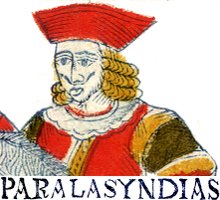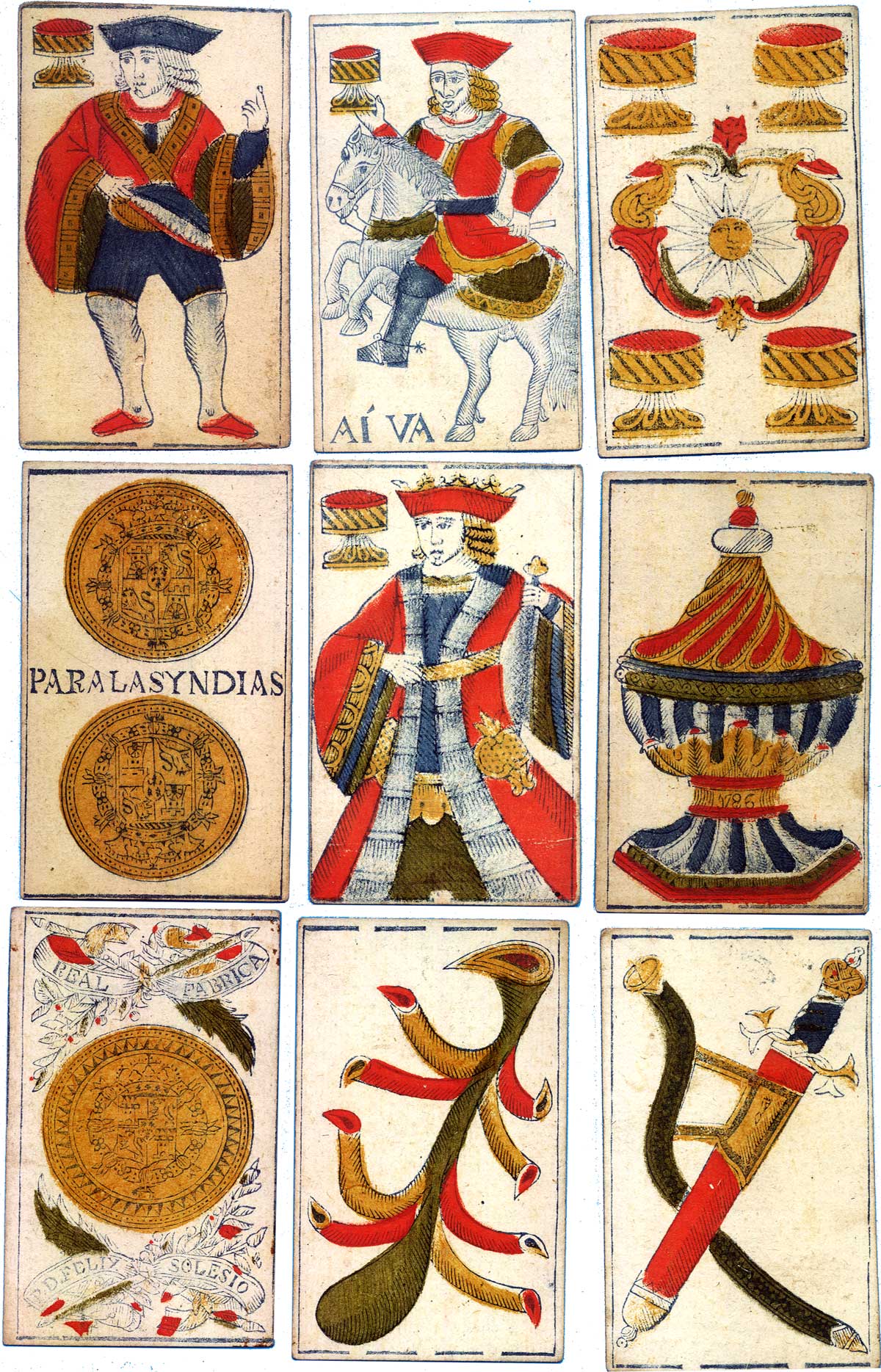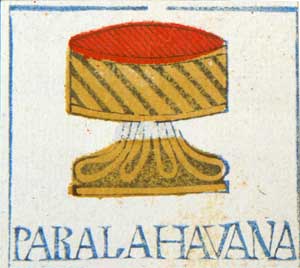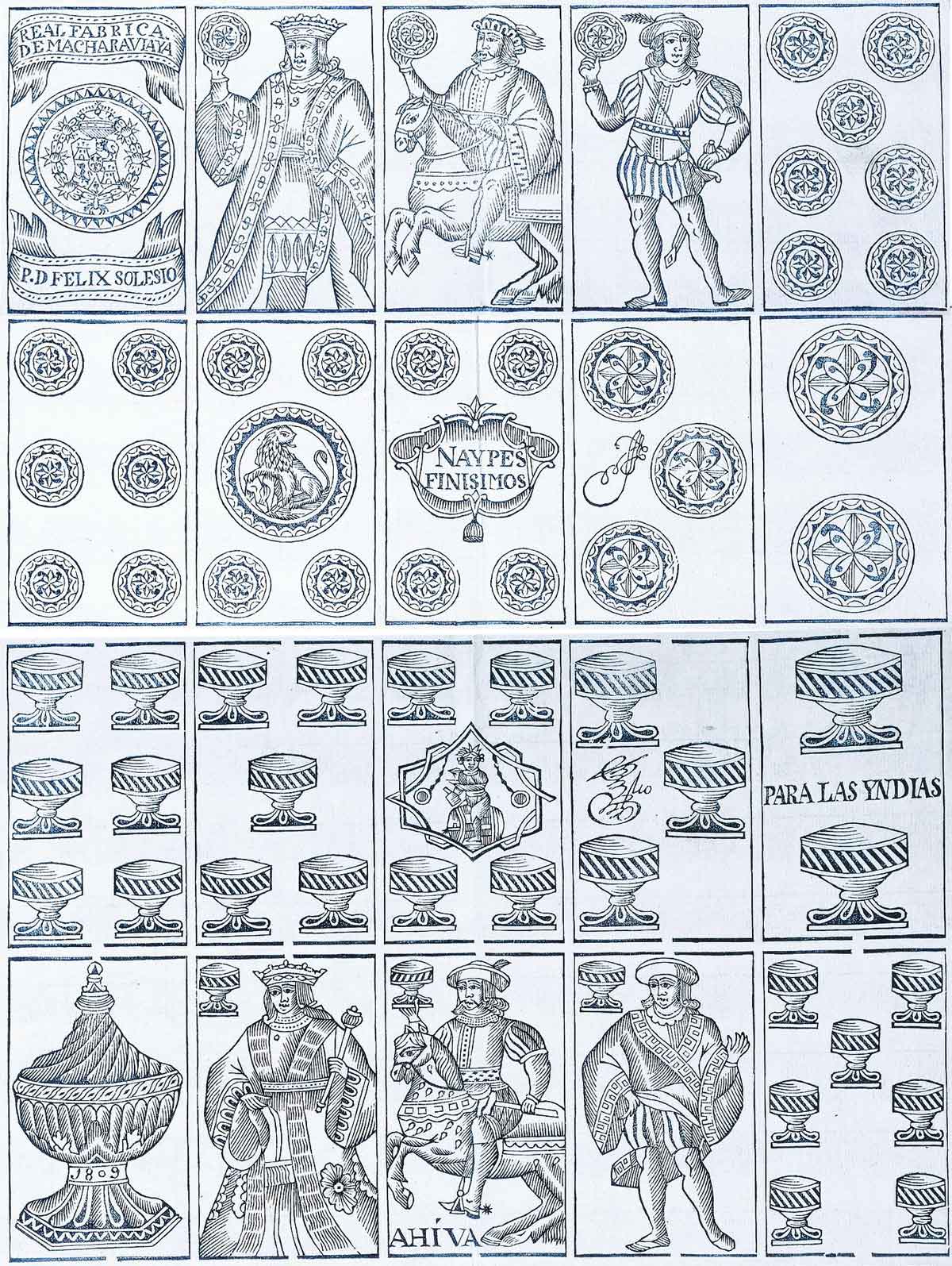Real Fábrica de Macharaviaya
This is the official Spanish National pattern of the 18th century. Design and production was controlled from Madrid as a source of national or regional revenue. The factory was located in the town of Macharaviaya, in the province of Málaga.
Real Fábrica de Macharaviaya (Málaga)
Félix Solesio

Revenues from the sales of playing cards in Central and South America had been a state monopoly since 1552, in the reign of Felipe II, who had issued a decree setting out the terms by which it was to be regulated. Packs were to be sold in paper wrappers tied with string and officially stamped. Officers were appointed to be in charge of ensuring the business was run correctly. To begin with cards destined for the Americas were manufactured solely in Mexico but due to irregular production as well as illegal imports (probably Italian) new orders were given that they should be produced in Spain.
The Real Fábrica de Madrid had been in existence since at least 1755, but in 1776 a Royal Letters Patent was issued authorising Don Félix Solesio to establish the Real Fábrica de Macharaviaya to supply playing cards to the Americas and particularly to Mexico - “Para las Indias”. The new factory was quickly built and was of benefit to the local community in terms of employment opportunities, urban development and cultural enrichment. It is recorded that in September 1777 15,000 decks produced in Macharaviaya were shipped to Mexico. Solesio was a distinguished name in the playing card industry, and as it happens, Félix Solesio's brother Lorenzo had been appointed master craftsman in the Portuguese Real Fábrica de Cartas de Jogar in 1769.



Above: an odd ace of coins having the arms of Spain on the suit-mark, above and below which are scrolls bearing poorly spelled inscriptions: 'Real Fabrica Macharaviaya por D. Felix Solesio e hijos.' © The Trustees of the British Museum
Above: cards from a pack by Don Félix Solesio destined for Mexico or South America, dated 1786 on the Ace of Cups. The two of Coins has the legend “Para las Indias”; in other examples this might be “Para Caracas” or “Para La Havana” showing that the packs were destined for Spanish colonies in Central (‘West Indies’) or South America. This is the official Spanish National pattern of the 18th century. Design and production was controlled from Madrid as a source of national or regional revenue. The factory was located in the town of Macharaviaya, in the province of Málaga►

Above: the former playing card factory at Macharaviaya. Photo credit: Marilo Marb.

Above: the former playing card factory at Macharaviaya. Photo credit: © 2017 Diputación de Málaga.
More Examples

Above: Spanish National pattern, Félix Solesio, Real Fábrica de Macharaviaya, 1809. Taken from: “Pruebas de naipes de la Real Fábrica de Macharaviaya (Málaga), para el tipo superfino”, Archivo General de Indias, MP-INGENIOS,210►
The date of closure of the Macharaviaya factory is reckoned to be 1815 [See here].
Several derivatives of this design have survived in various parts of the world, such as French ‘Aluette’ cards, ‘Parisian’ Spanish pattern (used in Uruguay) and cards used in North Africa. See also: Phelippe Ayet • Baraja Morisca • Seville 17th Century • Spanish National Pattern • Navarra 17th Century • Pedro Bosio and ‘Money Bag’ pattern • Portuguese Playing Cards • Rotxotxo Workshop Inventory • Joan Barbot • Gandarillas • Naipes Artiguistas
REFERENCES
Ferro Torrelles, Víctor: “Real Cédula aprobando el establecimiento de la Fábrica de Naipes de Macharaviaya” in La Sota Nº 16, Asescoin, Madrid, March 1997, pp.67-75
Pérez González, Alberto: “A Todos Alumbra”, facsimile of Baraja Carlos IV, Punto Verde, Benalmádena, 2006. See more →

By Simon Wintle
Member since February 01, 1996
Founder and editor of the World of Playing Cards since 1996. He is a former committee member of the IPCS and was graphics editor of The Playing-Card journal for many years. He has lived at various times in Chile, England and Wales and is currently living in Extremadura, Spain. Simon's first limited edition pack of playing cards was a replica of a seventeenth century traditional English pack, which he produced from woodblocks and stencils.
Leave a Reply
Your Name
Just nowRelated Articles

La Baraja del Mundial
“La Baraja del Mundial” satirical football deck published by Fournier for ‘Interviú’ news magazine. ...

Rouen Pattern - Portrait Rouennais
An attractive XV century French-suited design from Rouen became the standard English & Anglo-America...

Archaic Spanish proof sheets
2 x uncoloured proof sheets of archaic Spanish-suited playing cards produced for “New Spain”, possib...

Hispania Romana
Educational card game depicting the Roman period in Spanish history.

QAIPES – cartas españolas
Spanish-suited cards made in China inscribed “QAIPES” and “BAIPES”!

Baraja de la Cocina Española
A celebration of Spanish gastronomy, with designs by Silja Götz employing non-standard suits.

Ganjifa - Playing Cards from India
Indian playing cards, known as Ganjifa, feature intricate designs with twelve suits and are traditio...

Deportivo Alavés 1921-2021
Drawings by Guillem Bosch of famous Alavés footballers in celebration of the club’s centenary.

The Henry Hart Puzzle
Explore the intricate history and unique design variations of Henry Hart's playing cards, tracing th...

Naipes Kukuxumusu
A 52-card Spanish-suited advertising pack for a clothing company in Pamplona.

Euskal Herriko Mitologia
Important figures from Basque mythology, named in four languages.

Líneas rojas 2016
Semicaricatural images of Spanish politicians by Jordi Minguell, combined with non-standard suits. ...

Jeu des 7 familles basques
A Happy Families-type game from the Basque country, with designs by Soledad Bravi and Agathe de Las...

Sevilla 1647 reproduction
Facsimile of Spanish-suited pack produced in Sevilla, Spain, 1647.

Why our playing-cards look the way they do
Analysis of early playing card designs: origins, suit differences, standardization, technological ad...

Introduction to Collecting Themes
Playing cards can be broadly categorised into standard and non-standard designs, with collectors app...
Trending Articles
Popular articles from the past 28 days



 Your comment here. Your comment here. Your comment here. Your comment here. Your comment here. Your comment here. Your comment here. Your comment here. Your comment here. Your comment here. Your comment here. Your comment here. Your comment here. Your comment here. Your comment here. Your comment here. Your comment here. Your comment here. Your comment here. Your comment here. Your comment here. Your comment here. Your comment here. Your comment here. Your comment here. Your comment here. Your comment here. Your comment here. Your comment here. Your comment here. Your comment here. Your comment here.
Your comment here. Your comment here. Your comment here. Your comment here. Your comment here. Your comment here. Your comment here. Your comment here. Your comment here. Your comment here. Your comment here. Your comment here. Your comment here. Your comment here. Your comment here. Your comment here. Your comment here. Your comment here. Your comment here. Your comment here. Your comment here. Your comment here. Your comment here. Your comment here. Your comment here. Your comment here. Your comment here. Your comment here. Your comment here. Your comment here. Your comment here. Your comment here.